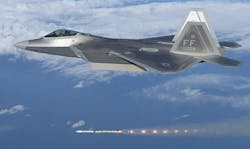Air Force orders hundreds of Raytheon AMRAAM air-to-air missiles in $573 million deal
EGLIN AIR FORCE BASE, Fla., 17 March 2016. U.S. Air Force airborne weapons experts are ordering several hundred of the nation's most sophisticated radar-guided air-to-air missiles under terms of a contract modification announced Wednesday.
Officials of the Air Force Life Cycle Manager Center at Eglin Air Force Base, Fla., are awarding a $573 million contract modification to the Raytheon Co. (NYSE:RTN) Missile Systems segment in Tucson, Ariz., for Lot 30 production of the AIM-120 Advanced Medium Range Air to Air Missile (AMRAAM) for the U.S. Air Force and Navy.
AMRAAM is one of the world's most advanced all-weather, all-environment medium range air-to-air missiles. The system is an active radar-guided intercept missile with inherent electronic protection capabilities for air-to-air applications against massed penetration aircraft and is designed to replace the AIM-7 Sparrow air-to-air missile.
Tuesday's order follows similar AMRAAM deals early last year for AMRAAM lots 28 and 29 production. Since December 2014 the Air Force has placed AMRAAM missile orders with Raytheon worth more than $1.5 billion.
Related: Kratos high-performance target drones to put air-to-air missiles through their paces
The latest version of AMRAAM, the AIM-120D, began fielding in 2014. Each AMRAAM lot typically contains between 400 and 500 missiles. The AIM-120D has improved accuracy via Global Positioning System (GPS)-aided navigation, improved network compatibility, and enhanced aircrew survivability via a two-way data link capability.
The AMRAAM missile has air-to-air and surface-launch versions. In the air-to-air role, the weapon's advanced active guidance section provides the aircrew find targets quickly in challenging environments, Raytheon officials say.
story continues below
AMRAAM has scored combat victories in the skies of Iraq, Bosnia, and Kosovo, Raytheon says. It uses digital technology, micro-miniaturized solid-state electronics, and active radar guidance for air combat and air defense.
AMRAAM provides multi-shot capability, and can be launched day or night, in all weather conditions. Its autonomous guidance capability provides the pilot with launch-and-leave ability to provide fast engagement of follow-on targets or the option to fire first and then run from targets.
AMRAAM's capabilities include quick fly-out, immunity to countermeasures, and the ability to reject radar clutter to attack low-altitude targets. The missile has active radar guidance, multi-shot capability, and the ability to launch from aircraft or from surface-to-air missile sites.
Related: Air Force asks Raytheon to develop enabling technologies for next-generation missiles
Raytheon also is developing the AMRAAM Extended Range missile for ground-based air defense, AMRAAM-ER will enable intercepts at longer distances and higher altitudes.
Procured by 36 countries, the AMRAAM has been integrated onto the F-16, F-15, F/A-18, F-22, Typhoon, Gripen, Tornado, and Harrier combat jets. The AIM-120C5 and AIM-120C7 are being integrated onto the F-35 Joint Strike Fighter and will be ready to meet F-35B initial operational capability when that time comes, company officials say.
On Wednesday's order, Raytheon will do the work in Tucson, Ariz., and should be finished by February 2019. For more information contact Raytheon Missile Systems online at www.raytheon.com, or the Air Force Life Cycle Manager Center at www.wpafb.af.mil/aflcmc.



